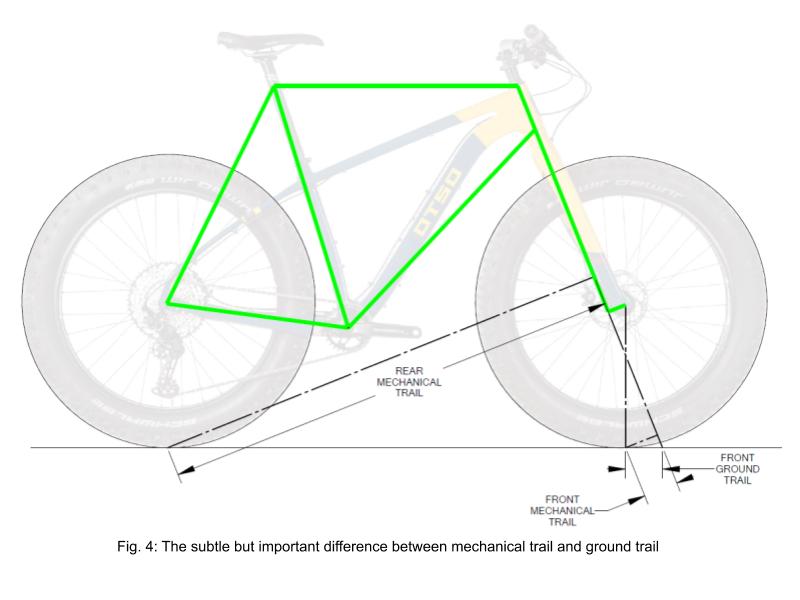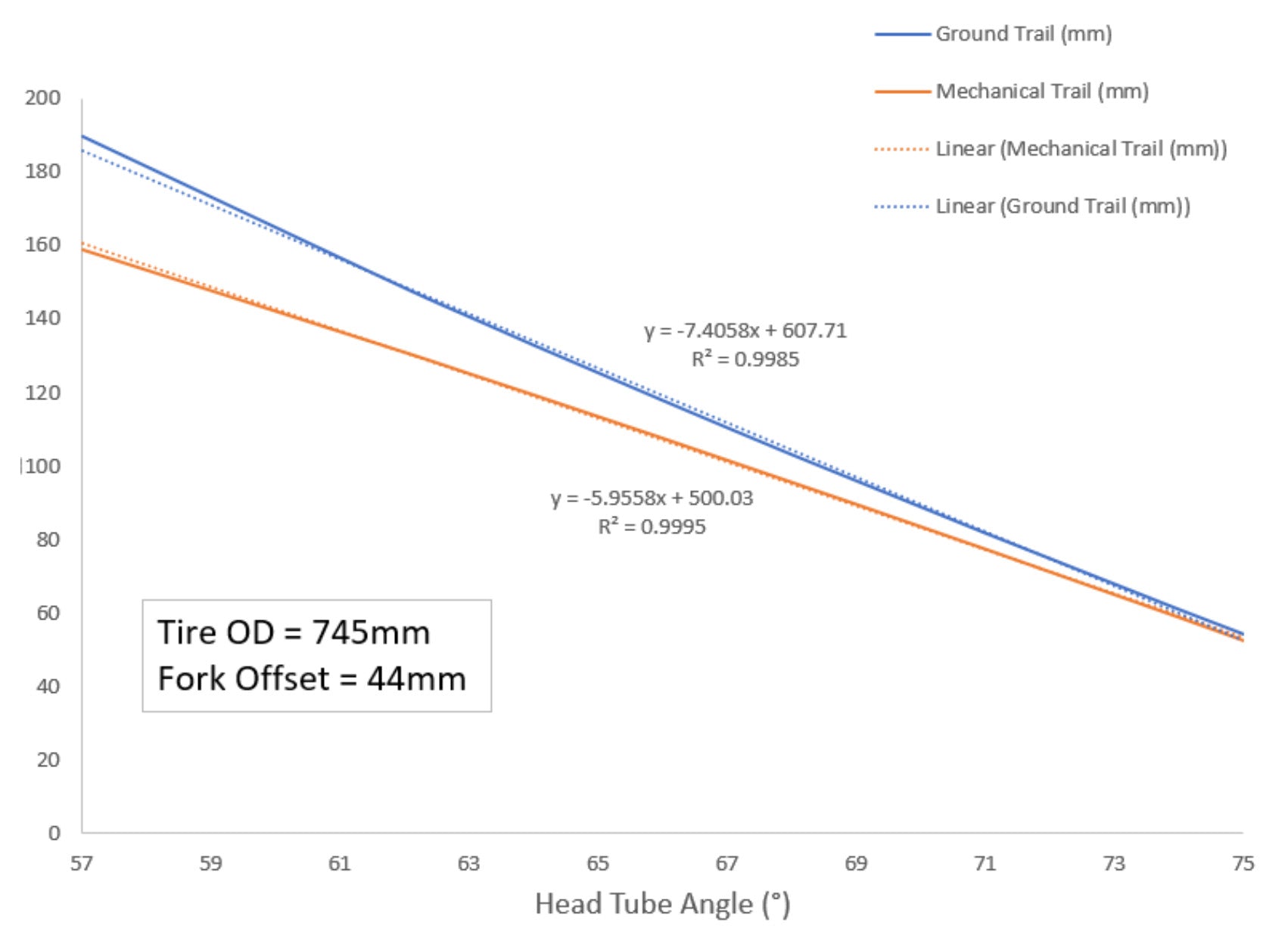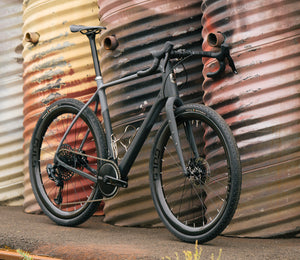GeoShift Angle Headset
What is head tube angle and why should I care?
In the bicycle world, we define head tube angle (or head angle for moderate brevity) as the angle between the center axis of the frame’s head tube (also called the steering axis), and the horizontal (90° being a vertical line). It is one of the fundamental factors that determine the handling characteristics of a two wheeled vehicle such as a bicycle or motorcycle.

You may have heard the terms “slack” or “steep” used in reference to head angle. These terms simply refer to head angles that fall toward the extreme ends of the spectrum; “steeper” head angles have higher values, “slacker” head angles have lower values.
Common bicycle head angles range from 63° to 74°, with very few outliers. This is a range of only 11°, essentially covering the entire world of modern bikes. Slacker angles (closer to 63°) are often seen on aggressive mountain bike styles such as enduro and downhill. Steeper angles (closer to 74°) are often seen on road and track racing bikes. Across any given discipline of bike style, it is common to see head angles that only vary by 3° or 4°. With this understanding, it becomes easier to imagine the significance a 1° difference in head angle can make between two otherwise equal bikes.
Why would I want to change my head tube angle?
Head tube angle is one of the most frequently discussed aspects of bike geometry. It’s right up there with wheel size and chainstay length, and for good reason. Head angle is one of the fundamental dimensions that will determine how your bike will handle.
There are three factors that determine the steering characteristics of the front-end of a bike. These factors are (1) Head Angle, (2) Wheel/tire size, and (3) Fork offset. Changing tire size with the sole intention of fine-tuning steering characteristics is generally unadvisable, as it will likely bring multiple other unwanted side effects to the bike’s geometry. Changing fork offset is a common method of adjusting steering geometry, but it typically will require the fork to be replaced, an expensive endeavor. A Wolf Tooth GeoShift will increase or decrease the headtube angle by 1°, resulting in discernible differences in front-end geometry at a fraction of the cost of a new fork.
Assuming nothing else about the bike is changed, decreasing the headtube angle by 1° will result in steering that is 5-7% more stable*. It will also put the front wheel farther in front of you (typically 10-12mm, but will depend on the length of your fork), increasing the wheelbase length and biasing your weight toward the rear of the bike. If you frequently ride fast, steep trails with larger impacts, and your bike’s handling doesn’t inspire the confidence you would like, you could benefit from a -1° head angle change.
Conversely, let’s say you have a bike that was originally designed for stability in high-speed descents, such as a modern enduro or all-mountain bike. Let’s also say that you most often ride in a place where extended high-speed descents are a rarity, let’s say east-central Minnesota. Trails around the Twin Cities tend to be more tight and twisty, a less wide-open high speed. Enduro or all-mountain bikes can feel “over-biked” - that is, the geometry built for flying down mountains can prove cumbersome on flatter, rolling, or more technical terrain. A +1° head angle change will decrease the steering stability by 5-7%. It will also bring the front wheel closer to you, shortening the overall wheelbase and placing more of your weight on the front tire. This is beneficial where quick steering with maximum front wheel traction is required.
An important note about increasing head tube angle - there will be a potential to introduce clearance issues with the front tire. Frame designers ensure that there will always be an acceptable amount of clearance between the pedals (and your toes) and the front tire. This needs to be verified not only at “top out”, where a suspension fork is uncompressed, but also throughout the range of front wheel suspension travel, and particularly at full-compression (bottom out). It also must be verified that the front wheel will not be able to come in contact with the frame at any point in its suspension travel.
*When we say “stable”, we are referring to the front mechanical trail value of the steering system. If you are interested, scroll down to read more about steering trail and how it will impact your bike’s handling.
A Tale of Two (or three) Trails
Before we get going, a quick disclaimer: discussions of steering geometry and handling characteristics can quickly get deep in the weeds. In the interest of keeping this piece digestible, and of the author someday returning to his works of creating cool bike parts instead of jargon-filled texts, we will merely make a shallow scratch on the surface of steering geometry and two-wheeled vehicle dynamics. If a comprehensive treatise on the subject is what you seek, I can’t recommend enough Tony Foale’s Motorcycle Handling and Chassis Design. A few more bullet points to keep in mind going forward:
- The individual dimensions of a bike’s geometry are largely interdependent. By changing any of the values, it is a safe bet that you will be changing most, if not all, of them. Changing a head angle by 1° will change trail, but also the reach, stack, effective top-tube length, BB drop/height, wheelbase, etc. These changes will be small, arguably negligible, but measurable.
- We will not be discussing the following topics, but you should totally google them later:
- Gyroscopic effects, angular acceleration, and other dynamic effects
- System center of gravity (CG) location and its effects on handling
- Effects of contact patch geometry or tire tread pattern
- Wheel flop
Trail, in simplest terms, is a measurement of the stability of your bike’s steering. When we say stability, we’re simply referring to how well a bike travels in a straight line. A bike with too little trail will feel “twitchy” - that is, small inputs from the rider at the handlebar will translate to large handling outputs. A bike with too much trail will be difficult to steer - larger inputs will be required from the rider at the handlebar to achieve their desired handling output (think of the phrase “steers like a boat”). A negative trail value will result in a steering system that is inherently unstable. Enjoy riding your bike no-handed? You have positive trail to thank.
Trail is essentially the measure of a lever arm that is working to make your bike go straight. The result of steering trail is often referred to as the “caster effect”. We’ve all seen the front wheels on a shopping cart (known as swivel casters). On a swivel caster, where the steering axis is vertical, the trail value is simple to determine - it is equal to the offset between the wheel center and the steering axis. Without too little offset, the shopping cart would be difficult to push down the aisle without running into the shelves. With too much offset, the cart would be difficult to maneuver around roadblocks.

On bicycles and motorcycles, the steering axis is not vertical, for a multitude of reasons that we won’t be getting into. This only means that calculating the trail value of the system is a little more complicated.
There are three numerical factors that will determine your bike’s trail value:
- Head tube angle
- Outer diameter of the tire
- Fork offset
 Note that axle-to-crown (A-C) length of the fork is not one of the factors here. This is because when you look up the head tube angle of a frame, there is an assumption that a fork with the manufacturer’s original intended A-C length is being used. If you have a frame with a fork of non-stock dimensions, you will need to determine the head tube angle yourself. Fork A-C length will be a factor in determining changes to wheelbase and front center, more on that later.
Note that axle-to-crown (A-C) length of the fork is not one of the factors here. This is because when you look up the head tube angle of a frame, there is an assumption that a fork with the manufacturer’s original intended A-C length is being used. If you have a frame with a fork of non-stock dimensions, you will need to determine the head tube angle yourself. Fork A-C length will be a factor in determining changes to wheelbase and front center, more on that later.
There is a point of contention we need to address regarding how we define trail. When we talk about trail, we are talking about mechanical trail (MT). This is to be distinguished from ground trail (GT), as illustrated below. Ground trail is a bit easier to visualize, and is thus more commonly presented as trail in a general sense. There are mechanical trail and ground trail values for both the front and rear wheel of a bike, but we are primarily concerned with the front mechanical trail in this discussion. Generally, when the term “mechanical trail” is used without a front/rear modifier leading, it is implied that the reference is to front mechanical trail. From here forward we will use the abbreviations FMT for front mechanical trail and RMT for rear mechanical trail.
 The mechanical vs. ground trail distinction may understandably seem trivial. The difference, though, while subtle, is important to our discussion and our understanding of what trail is doing. Earlier we stated that trail is analogous to a lever arm trying to make your front wheel go straight. The length of a lever arm is defined as the distance from the fulcrum point or pivot axis to the point where force is applied, measured perpendicular to the axis of rotation. This is exactly how mechanical trail is measured. Ground trail is measured parallel to the horizontal, which is perhaps easier to picture mentally, but is geometrically irrelevant and presents unnecessary complication in discussions of front end mechanics. For example - if you swap out your fork to a unit off a different offset, your mechanical trail will change by the same amount, since these are both measured perpendicular to the steering axis. To determine the change in ground trail requires trigonometry, added complication to achieve a less informative metric.
The mechanical vs. ground trail distinction may understandably seem trivial. The difference, though, while subtle, is important to our discussion and our understanding of what trail is doing. Earlier we stated that trail is analogous to a lever arm trying to make your front wheel go straight. The length of a lever arm is defined as the distance from the fulcrum point or pivot axis to the point where force is applied, measured perpendicular to the axis of rotation. This is exactly how mechanical trail is measured. Ground trail is measured parallel to the horizontal, which is perhaps easier to picture mentally, but is geometrically irrelevant and presents unnecessary complication in discussions of front end mechanics. For example - if you swap out your fork to a unit off a different offset, your mechanical trail will change by the same amount, since these are both measured perpendicular to the steering axis. To determine the change in ground trail requires trigonometry, added complication to achieve a less informative metric.
A few notes about RMT - this is simply a more accurate way to describe the steering effects of wheelbase (the horizontal distance between your front and rear axles). Any change to FMT will be met with a change in RMT. That is, an increase to FMT will result in an increase in RMT, a decrease in FMT will result in a decrease in RMT. These changes will not be equal in magnitude, but not far off. The percentage change of RMT will be much less than the percentage change of FMT for 1° of head angle change (0.5-1% change in RMT compared to 5-7% change in FMT). A change of RMT of less than 1% isn’t something I’d say warrants much consideration.
There is another reason why mechanical trail and ground trail should not be used interchangeably; with changes in head angle, MT and GT will change at different rates. Across a span of head angles from 57° to 75° (beyond the limits of what is commonly seen on bicycles), MT and GT values will both be nearly linear, but with significantly different rates:

Calculating Trail Values
Determining the front mechanical trail, while it requires some basic trigonometry, is actually quite simple (assuming your bike has its stock fork, or one of similar dimensions). You’ll need to know three things: the head tube angle, the fork offset, and the outer diameter of your front tire (refer back to Fig. 3 for illustration of these dimensions).
Your head angle should be listed in the manufacturer’s geometry table for your frame. If you have a hardtail frame with a suspension fork, see if you can find a head tube angle listed at “sag”, where the fork is under initial compression from rider weight. Same deal for fork offset - you should be able to look this up from your bike manufacturer’s website. Many suspension forks these days have their offset values displayed on the outside of the fork. If you don’t know your fork offset or your head angle, and you’re unable to look it up, it will be a bit difficult to measure accurately without some dedicated fixturing.
Tire outer diameter (OD) is seldom, if ever, listed by tire manufacturers in the bike world. This is partly because tire OD will change depending on the internal width of your rim, but also because the world of tire sizing standards is notoriously cryptic and optimized to induce confusion and rage (did you know that a 29” wheel is smaller than a 27” wheel? Or that a 28” tire goes on a 29” rim? It really is wild out here). My point is, to determine the OD of your tire, the only reliably accurate way is to measure it yourself.
There are several ways to measure tire OD. The easiest way is to measure the circumference and divide by π (roughly 3.14). The circumference, C, can be measured with soft measuring tape, or by rolling the tire exactly one full rotation and measuring the distance traveled.
 The matter of tire OD gets a little mucked up by the fact that your tire compresses underneath your weight, decreasing its effective diameter. How much the tire compresses will depend on tire size, pressure, and the combined weight of you and the bike. For the sake of this discussion staying remotely on the rails, we’re going to assume that your tires are rock-hard and don’t compress under your weight.
The matter of tire OD gets a little mucked up by the fact that your tire compresses underneath your weight, decreasing its effective diameter. How much the tire compresses will depend on tire size, pressure, and the combined weight of you and the bike. For the sake of this discussion staying remotely on the rails, we’re going to assume that your tires are rock-hard and don’t compress under your weight.
Now that you know head angle (HA), fork offset, and tire OD, you can find mechanical trail with the following formula:
 There is a common misconception that increasing fork offset increases steering stability. It’s actually the exact opposite. As you can see in Equation 2 above, the mechanical trail (and thus steering stability) will decrease as fork offset is increased. The same will be true for head angle - increasing head angle will decrease mechanical trail.
There is a common misconception that increasing fork offset increases steering stability. It’s actually the exact opposite. As you can see in Equation 2 above, the mechanical trail (and thus steering stability) will decrease as fork offset is increased. The same will be true for head angle - increasing head angle will decrease mechanical trail.
 Wolf Tooth GeoShift Performance Angle Headset
Wolf Tooth GeoShift Performance Angle Headset





